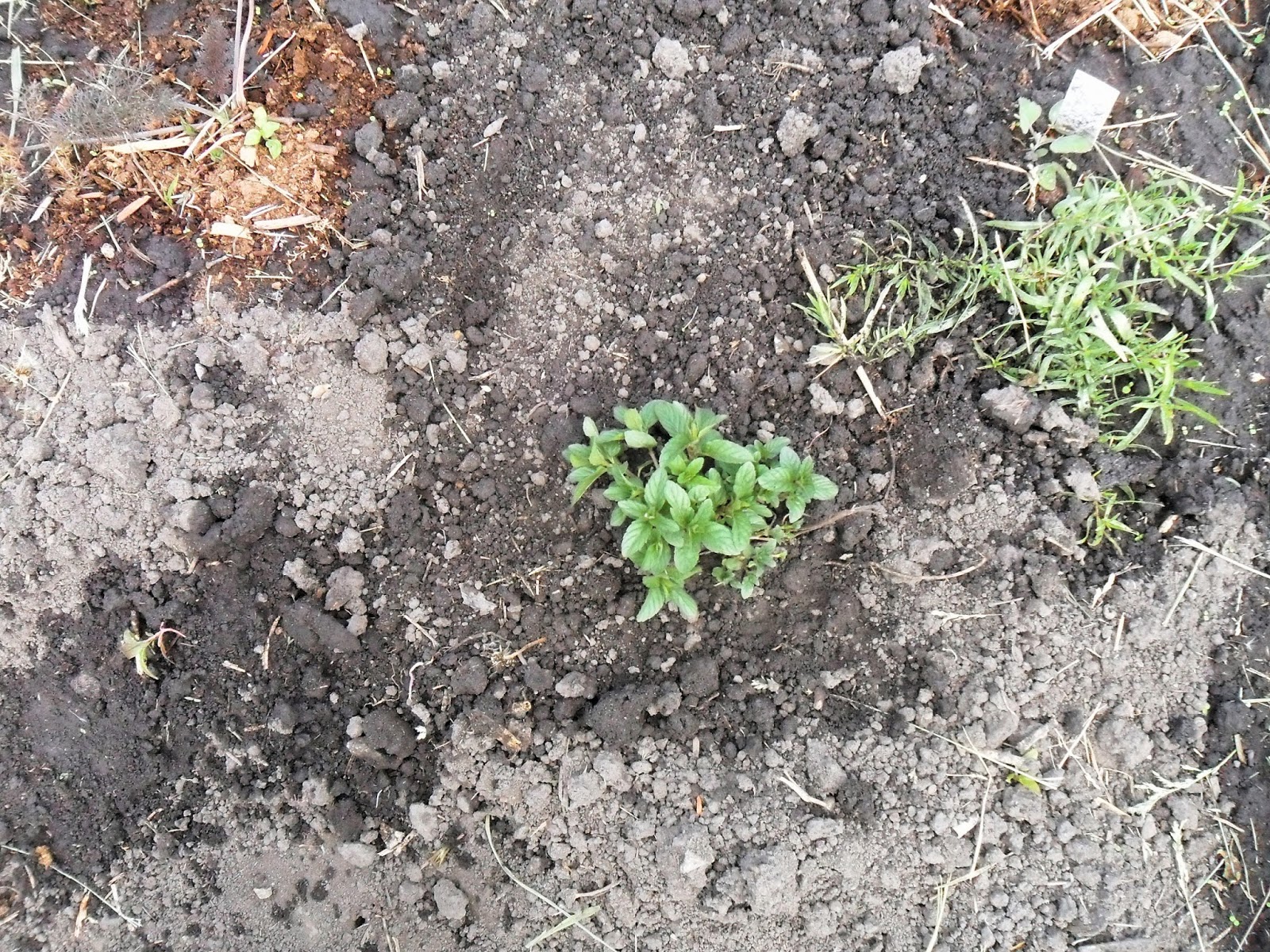I visit the garden almost daily. Mostly to water it if it does not rain, but also to see if it needs anything. Do I have bug or rodent issues? Do the weeds need taming? Things like that.
Here is the garden just after planting:
Here is the garden as of May 26th:
Here is is on May 31st. Just in 4 days you can see it got more growth.
You can tell some things have gotten bigger and that I planted a few more seeds since the first weekend. But progress is slow at first (the real reason I do not take a progress picture everyday!)
I think from now on I will take a picture on Sunday and update the blog shortly after that. The best news on this particular day is that the greens seeds (lettuces) that I planted on the first weekend have germinated. Here is a close up. In the next few days I will need to thin the plants to the correct spacing, but for now I will just enjoy the fact that germination has occurred!
Problems in the Garden
The bummer item on the list this week is that there are cucumber beetles in the garden. This particular insect can winter over in the soil so its emergence just days after I planted the garden is unfortunate but not surprising. I used the Organic method of squashing them whenever I saw them as the first line of defense, but they still did some major damage to the the leaves of the cucumber plants. They have also attacked the acorn squash. I more radical method will be to steep tobacco leaves and mix the tincture with water and dish soap and spray the leaves. I am preparing that solution now.
I think the stress of the warm weather and the long time in the too small pots reduced the plants ability to resist and repel the insects, so I will have to help them fight back.
What is a Cucumber Beetle?
Cucumber beetle is a common name given to members of two genera of beetles, Diabrotica and Acalymma, both in the family Chrysomelidae. The adults can be found on cucumbers and a variety of other plants. Many are notorious pests of agricultural crops. The larvae of several cucumber beetles are known as corn rootworms.
Some well-known pests include the western corn rootworm (D. virgifera virgifera), the spotted cucumber beetle and its larva, the striped cucumber beetle (A. vittatum), and the western striped cucumber beetle(A. trivittatum). These should not be confused with the Colorado Potato Beetle which also has stripes.
Cucumber beetles can overwinter in crop fields or in compost or trash piles. Eradication efforts may include manual removal, clearing cultivated areas of litter, debris, and infested plants, and application of pyrethrin-containing insecticides such as Cyfluthrin or non-systemic organphosphate insectsides such as Malathion.
Here is the garden just after planting:
Here is the garden as of May 26th:
Here is is on May 31st. Just in 4 days you can see it got more growth.
You can tell some things have gotten bigger and that I planted a few more seeds since the first weekend. But progress is slow at first (the real reason I do not take a progress picture everyday!)
I think from now on I will take a picture on Sunday and update the blog shortly after that. The best news on this particular day is that the greens seeds (lettuces) that I planted on the first weekend have germinated. Here is a close up. In the next few days I will need to thin the plants to the correct spacing, but for now I will just enjoy the fact that germination has occurred!
 |
| Micro Greens Mild Mix (from Botanical Interest Seeds) |
 |
| Black Beauty Zucchini (Botanical Interest) only 4 days to be this big |
 |
| Sunflower Teddy Bear (Baker Creek Heirloom seeds) These took two weeks to germinate but at a two foot high sunflower! |
The bummer item on the list this week is that there are cucumber beetles in the garden. This particular insect can winter over in the soil so its emergence just days after I planted the garden is unfortunate but not surprising. I used the Organic method of squashing them whenever I saw them as the first line of defense, but they still did some major damage to the the leaves of the cucumber plants. They have also attacked the acorn squash. I more radical method will be to steep tobacco leaves and mix the tincture with water and dish soap and spray the leaves. I am preparing that solution now.
 |
| Here you can see the damage close up. |
I think the stress of the warm weather and the long time in the too small pots reduced the plants ability to resist and repel the insects, so I will have to help them fight back.
What is a Cucumber Beetle?
Cucumber beetle is a common name given to members of two genera of beetles, Diabrotica and Acalymma, both in the family Chrysomelidae. The adults can be found on cucumbers and a variety of other plants. Many are notorious pests of agricultural crops. The larvae of several cucumber beetles are known as corn rootworms.
 |
| Cucumber Beetle |
 |
| At one point last year, I thought they were artistic! (This image is on a greeting card I made from a photo I took of Black-eyed Susan.) |
Some well-known pests include the western corn rootworm (D. virgifera virgifera), the spotted cucumber beetle and its larva, the striped cucumber beetle (A. vittatum), and the western striped cucumber beetle(A. trivittatum). These should not be confused with the Colorado Potato Beetle which also has stripes.
The insects live about eight
weeks, during which time both larva and adult feed on plants. Adults will
attack the tender young growth of stems and leaves, and the buds and petals on
mature specimens. They also carry and spread the bacterial wilt organism Erwinia tracheiphila and the cucumber mosaic virus. Eggs are laid
in clusters on the undersides of host leaves and hatch into larvae 1⁄2 inch (13 mm) long. The larvae
often tunnel into the soil to attack roots.
Cucumber beetles can overwinter in crop fields or in compost or trash piles. Eradication efforts may include manual removal, clearing cultivated areas of litter, debris, and infested plants, and application of pyrethrin-containing insecticides such as Cyfluthrin or non-systemic organphosphate insectsides such as Malathion.
How to Identify Cucumber Beetles
Adults
are about ¼ inch long and have a yellow and black striped abdomen and a dark
colored head and antennae. Look for holes and yellowing and wilting leaves.
Crop yield will be low; and plants will produce yellow and stunted fruits. The
larvae are worm-like, white, dark-headed, a have three pairs of legs on the
thorax.
Often,
the Cucumber Beetles alone will not kill the plants or cause major damage, but
the spread of disease will. Adult cucumber beetles overwinter in weeds, garden
debris and woody areas. The diseases they carry can also overwinter internally,
and can be passed onto plants the next spring through fecal matter.
How to Control Cucumber Beetles
- Inspect newly planted cucurbit plants for the presence of this beetle; be watchful when plants are seedlings.
- Cover seedlings with row covers, though you must remove during blossoming time several hours each day to allow pollination.
- If you till your garden in the late fall, you will expose cucumber beetles hiding there to harsh winter conditions and reduce their populations next year. Tilling has the added benefit of making the soil easier to work in the spring.
- Where cucumber beetles are a problem, let the beetles come out of hiding and plant late. They have a knack for finding vulnerable seedlings. When yours are up and growing, the cucumber beetles will be gone, fooled into thinking you don't have any cucumbers in your garden.
- Few insecticides can be used on cucurbit plants because they are very sensitive. They would need to be used when plants are beginning to emerge through the soil. Please contact your local cooperative extension for a list of approved insecticides for your area.
- Natural predators include soldier beetles, braconid wasps, some nematodes, and soldier beetles.
.JPG)

.JPG)




































